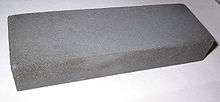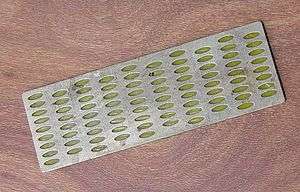Sharpening stone

Sharpening stones, water stones or whetstones are used to grind and hone the edges of steel tools and implements.
Examples of items that may be sharpened with a sharpening stone include scissors, scythes, knives, razors and tools such as chisels, hand scrapers and plane blades. Though it is sometimes mistaken as a reference to the water often used to lubricate such stones, the word "whetstone" is a compound word formed with the word "whet", which means to sharpen a blade,[1][2] not the word "wet". The process of using a sharpening stone is called stoning.[3]
Natural stones versus artificial stones
The use of natural stone for sharpening has diminished with the widespread availability of high-quality, consistent particle size artificial stones.
As a result, the legendary Honyama mines in Kyoto, Japan, have been closed since 1967. Belgium currently has only a single mine that is still quarrying Coticules and their Belgian Blue Whetstone (BBW) counterparts.[4]
Modern synthetic stones are generally of equal quality to natural stones, and are often considered superior in sharpening performance due to consistency of particle size and control over the properties of the stones. For example, the proportional content of abrasive particles as opposed to base or "binder" materials can be controlled to make the stone cut faster or slower, as desired.[5] Natural stones are often prized for their natural beauty as stones and their rarity, adding value as collectors' items. Furthermore, each natural stone is different, and there are rare natural stones that contain abrasive particles in grit sizes finer than are currently available in artificial stones.
One of the most well-regarded natural whetstones is the yellow-gray "Belgian Coticule", which has been legendary for the edge it can give to blades since Roman times, and has been quarried for centuries from the Ardennes. The slightly coarser and more plentiful "Belgian Blue" whetstone is found naturally with the yellow coticule in adjacent strata; hence two-sided whetstones are available, with a naturally occurring seam between the yellow and blue layers. These are highly prized for their natural elegance and beauty, and for providing both a fast-cutting surface for establishing a bevel and a finer surface for refining it. This stone is considered one of the finest for sharpening straight razors.
The hard stone of Charnwood Forest in northwest Leicestershire, England, has been quarried for centuries,[6] and was a source of whetstones and quern-stones.
Manufacturing process
Abrasive stones are made by sintering powdered metal, ceramics, and clay just below their melting points.
Japanese waterstones

The Japanese traditionally used natural sharpening stones lubricated with water (using oil on a waterstone reduces its effectiveness.) They have been doing this for many hundreds of years. The geology of Japan provided a type of stone which consists of fine silicate particles in a clay matrix, somewhat softer than Novaculite.
Japanese stones are also sedimentary. The most famous are typically mined in the Narutaki District just north of Kyoto.
Advantages and disadvantages
The softer Japanese stones have a few advantages over harder stones. First, because they are softer they do not become glazed or loaded with the material they are sharpening. New particles are constantly exposed as they wear down, so that they continue to cut consistently. Second, they can be lubricated effectively with water (rather than oil, which can ruin some stones), so nothing but water is required. Finally, because they are soft, the worn material and the water form a slurry that, in conjunction with the stone, sharpens and polishes the blade.
A disadvantage is that they become uneven faster than other types of sharpening stone, although the softness then makes them easier to flatten, wearing out the stone faster and require replacement sooner. However, some handsharpening techniques utilise high points on stones changing this disadvantage to an advantage.
Grades of waterstones
Historically, there are three broad grades of Japanese sharpening stones: the ara-to, or "rough stone", the naka-to or "middle/medium stone" and the shiage-to or "finishing stone". There is a fourth type of stone, the nagura, which is not used directly. Rather, it is used to form a cutting slurry on the shiage-to, which is often too hard to create the necessary slurry. Converting these names to absolute grit size is difficult as the classes are broad and natural stones have no inherent "grit number". As an indication, ara-to is probably (using a non-Japanese system of grading grit size) 500–1000 grit. The naka-to is probably 3000–5000 grit and the shiage-to is likely 7000–10000 grit. Current synthetic grit values range from extremely coarse, such as 120 grit, through extremely fine, such as 30,000 grit (less than half a micrometer abrasive particle size).
Diamond plate

A diamond plate is a steel plate, sometimes mounted on a plastic or resin base, coated with diamond grit, an abrasive that will grind metal. When they are mounted they are sometimes known as diamond stones. The plate may have a series of holes cut in it that capture the swarf cast off as grinding takes place, and cuts costs by reducing the amount of abrasive surface area on each plate. Diamond plates can serve many purposes including sharpening steel tools, and for maintaining the flatness of man-made waterstones, which can become grooved or hollowed in use. Truing (flattening a stone whose shape has been changed as it wears away) is widely considered essential to the sharpening process but some hand sharpening techniques utilise the high points of a non-true stone. As the only part of a diamond plate to wear away is a very thin coating of grit and adhesive, and in a good diamond plate this wear is minimal due to diamond's hardness, a diamond plate retains its flatness. Rubbing the diamond plate on a whetstone to true (flatten) the whetstone is a modern alternative to more traditional truing methods.[7]
Diamond plates are available in various plate sizes (from credit card to bench plate size) and grades of grit. A coarser grit is used to remove larger amounts of metal more rapidly, such as when forming an edge or restoring a damaged edge. A finer grit is used to remove the scratches of larger grits and to refine an edge. There are two-sided plates with each side coated with a different grit.
The highest quality diamond sharpeners use monocrystalline diamonds, single structures which will not break, giving them an excellent lifespan. These shatter-resistant diamonds can be bonded onto a precision ground surface, set in nickel, and electroplated. This process locks the diamonds in place through a complex manufacturing process. Diamond stones are not designed to replace traditional sharpening stones, sandpaper, grinders, or any other abrasives. Instead, they are designed to work with these sharpening devices to cover all your sharpening needs, while maintaining their own place with some specific advantages, such as speed, ease of use, durability, and versatility.[8]
See also
References
- ↑ ""Whet", Dictionary.com". Retrieved 25 July 2016.
- ↑ "Online Etymology Dictionary". Retrieved 25 July 2016.
- ↑ ""Stoning", Dictionary.com". Retrieved 25 July 2016.
- ↑ http://www.coticule.be/faq-reader/items/how-does-a-belgian-blue-whetstone-compare-to-a-coticule-40a-story-about-garnets41.html
- ↑ English, John (2008), Woodworker's Guide to Sharpening: All You Need to Know to Keep Your Tools Sharp, Fox Chapel Publishing, p. 22, ISBN 978-1-56523-309-6.
- ↑ Ambrose, K et al. (2007). Exploring the Landscape of Charnwood Forest and Mountsorrel. Keyworth, Nottingham: British Geological Survey
- ↑ Miller, Jeff (2012). The Foundations of Better Woodworking: How to use your body, tools and materials to do your best work, Popular Woodworking Books, 2012 ISBN 1440321019, page 120
- ↑ http://www.wonkeedonkeetrend.co.uk/diamond-sharpening/diamond-sharpening-stones/
| Wikimedia Commons has media related to Sharpening tools. |